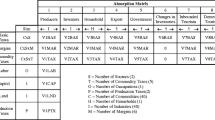Abstract
With global climate change, the extreme flood disasters which are characterized with low frequency but huge economic losses occur more frequently. The management of the extreme flood disasters mainly depends on the administrative means of the governments at all levels in China. When the extreme flood occurs, the government financial aid and the social donation can be used to compensate the catastrophe losses, but these compensations account for only a small part of the catastrophe losses. Therefore, it is very urgent to disperse the flood catastrophe risk by social system. The catastrophe risk securitization bridges the capital market and the insurance market and can effectively transfer the catastrophe risk to the capital market. The catastrophe bond is an effective risk dispersion mode and the pricing of catastrophe bonds is the core issue of implementing catastrophe bonds. However, the research about the design and the pricing of extreme flood catastrophe bond is scarce. In this study, a kind of one-year extreme flood catastrophe bond was designed and simulations on the pricing according to the extreme flood data in China during 1961 to 2009 with quantitative analysis method were done, combined with the non-life insurance actuarial method and Wang-double-factor model. The results show that price of catastrophe bond is increasing with the increase of the value for triggering points and reducing when the ratio that corporation confiscates the capital and the interest of catastrophe bond enlarges. Some reasons were discussed to account for the results. The results show that the method is effective and can provide some guidance for the pricing of extreme flood catastrophe bonds.



Similar content being viewed by others
References
Abhijit B, Munindra B, Rakesh K (2010) Regional flood frequency analysis of North-Bank of the River Brahmaputra by using LH-Moments. Water Resour Manag 24(9):1779–1790
Andre JA (2010) Unger. Pricing index-based catastrophe bonds: part 1 formulation and discretization issues using a numerical PDE approach. Comput Geosci 36(2):139–149
Betul S (2009) Regional flood frequency analysis using L-Moments for the West Mediterranean Region of Turkey. Water Resour Manag 23(3):531–551
Christofides S (2004) Pricing of catastrophe linked securities. Working Paper, www.actuaries.org/ASTIN/Colloquia/Bergen/Christofides.pdf
Cox SH, Pedersen HW (2000) Catastrophe risk bonds. N Am Actuar J 4(4):56–82
Egami M, Virginia RY (2008) Indifference prices of structured catastrophe (CAT) bonds. Insur: Math Econ 42(2):771–778
Hou F, Jin DY (2010) Pricing cat bond based on the B-K binomial tree rate model. Math Pract Theory 40(2):51–57 (in Chinese)
IPCC (2007) Summary for policy makers of the synthesis report of the IPCC Fourth Assessment Report. Cambridge University Press, Cambridge
Lane MN (2000) Pricing risk transfer transactions. Astin Bull 30(2):259–293
Li Y (2005a) Prevention for catastrophic risk in the construction of harmonious society-Study on the securitization of seismic risk in China. N China Earthq Sci 23(4):45–49 (in Chinese)
Li YQ (2005b) Research on catastrophe insurance risk securitization. China Financial & Economic Press, Beijing (in Chinese)
Lin X (2009) A study on the pricing of interest rate of typhoon bond in China, Master Thesis of Xiamen University, Xiamen (in Chinese)
Neil MB, Fcas M, Gan YB (2009) An analysis of the market price of CAT bonds. Casualty Actuarial Society E-Forum, spring, http://www.casact.org/pubs/forum/09spforum/02Bodoff.pdf
Qiu L, Wang HM, Ma SJ (2009) Assessment method for extreme flood disaster losses and its application. Adv Water Sci 20(6):869–875 (in Chinese)
Robert AJ (2010) A simple robust model for Cat bond valuation. Financ Res Lett 17(2):72–79
Shi JX, Wu YL (2006) The research on the catastrophic insurance risk securitization in China: the design of typhoon catastrophe bond. J Financ Res 5:103–112 (in Chinese)
Tian L (2009) Research on operation model and pricing mechanism of catastrophe bonds. Wuhan University Press, Wuhan (in Chinese)
Tian L, Zhang Y (2008) Review on evolution of cat bond pricing model. J Wuhan Univ 61(5):650–654 (in Chinese)
Wang XJ (2002) The Methodological research of constructing the model of distribution of loss resulting from property insurance. Stat Res 11:40–43 (in Chinese)
Wang XJ (2003) Modeling the distribution of property losses and the relevant experimental analysis. Stat Res 03:58–64 (in Chinese)
Wang SS (2004) Cat bond pricing using probability transforms. Insurance and the State of the Art in Cat Bond Pricing, Working Paper Series, Geneva Association, 19–29
Wang WG, Xing WQ, Yang T (2012) Characterizing the changing behaviours of precipitation concentration in the Yangtze River Basin, China. Hydrol Process. doi:10.1002/hyp.9430
Wu L, Yang JP (1997) Non-Life insurance loss distributions and loss reserve methods. Appl Stat Manag 16(1):54–61 (in Chinese)
Xia SQ (2010) Operation and lessons of Caribbean catastrophe risk insurance fund. Financ Sci 1:32–39 (in Chinese)
Yang Y (2009) The research on catastrophe bonds pricing model. Appl Stat Manag 28(5):942–950 (in Chinese)
Yang K, Qi ZY (2007) Study on the reference point effect theory used in catastrophe bond pricing method. J China Soft Sci 11:141–149 (in Chinese)
Zamir H (2011) Application of the regional flood frequency analysis to the upper and lower basins of the Indus River, Pakistan. Water Resour Manag 25(11):2797–2822
Zhou Y, Yan HL (2011) Empirical studies on flood bond and pricing-analysis on China’s flood bond pricing based on the Wang two factors model. J Shanghai Finance Univ 3:40–49 (in Chinese)
Zhu MH (2010) On pricing for earthquake catastrophe bond based on Wang-double-factor transformation. Rev Econ Res 38:58–64 (in Chinese)
Acknowledgements
This work was supported by the National Society Science Fund of China (09CJY020), the National Nature Science Foundation of China (90924027) and the Special Fund of State Key Laboratory of Hydrology-Water Resources and Hydraulic Engineering of China (2011585312). The authors also thank the anonymous reviewers and the editor-in-chief for their valuable comments which greatly help to improve the quality of the paper.
Author information
Authors and Affiliations
Corresponding author
Rights and permissions
About this article
Cite this article
Chen, J., Liu, G., Yang, L. et al. Pricing and Simulation for Extreme Flood Catastrophe Bonds. Water Resour Manage 27, 3713–3725 (2013). https://doi.org/10.1007/s11269-013-0376-2
Received:
Accepted:
Published:
Issue Date:
DOI: https://doi.org/10.1007/s11269-013-0376-2




